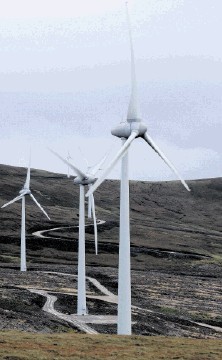
THE Scottish Government was under fire last night after it emerged it has approved 83% of all major onshore windfarm applications submitted in the last five years.
Official figures showed SNP ministers have given the go-ahead to 29 of 35 developments, many of them in the north and north-east, since taking power in 2007.
Critics said the statistics were “alarming” and illustrated the government’s obsession with wind power despite widespread concerns about the impact of turbines on the landscape and nearby communities.
Conservative chief whip John Lamont claimed the figures sent out a message to big developers – “come straight to us and you have an 80% chance of success”.
Helen McDade, head of policy at conservation charity John Muir Trust, said there was a “high risk” of the planning system falling into disrepute, particularly given the government had the power to overrule public inquiry decisions.
The government – which has claimed tourists are largely indifferent to sensitively sited turbines – has set a target of generating 100% of electricity from renewables by 2020.
Scotland’s local authorities deal with smaller developments but those more than 50MW require ministerial consent under Section 36 of the Electricity Act.
A Scottish Government spokeswoman said every application was “carefully considered” and takes all views, including environmental impact, into account before a decision is made.
“Of the 35 windfarm decisions taken by Scottish ministers since 2007, they have backed the opinion of the local authority over 70% of the time,” she added.
The figures showed ministers have approved seven applications in the Highlands, three in Moray, two in Shetland, two in the Western Isles and one in Aberdeenshire since September 2007.
Mr Lamont said: “The message this sends out to big windfarm companies is ‘come straight to us and you have an 80% chance of success’.
“It is bad enough that the Scottish Government overturns rejections made by councils, but people will now be asking what kind of scrutiny are ministers giving to these applications?” added the Tory MSP.
Ms McDade said: “We are concerned that developments that clearly impact on environmen-tal qualities have been given permission when it seems clear there if there are very good planning policies that should not happen.
“Local people do not have any confidence in the system, particularly if you can win at a public inquiry then still be overruled by the government.
“The planning system is at high risk of falling into disrepute.”
Moray Council planning convener Douglas Ross said: “The figures regarding wind turbines get more and more alarming and it is amazing there should be such a high percentage of Section 36 approved by the government.
“I also have a concern that local authorities will stop objecting to Section 36 applications as these automatically trigger a local inquiry which councils have to foot the bill for.
“I worry that councils will decide it’s not worth objecting as they could spend a lot of money when the outcome is almost a fait accompli,” added Councillor Ross.
Windfarm protester Lyndsey Ward, of Kiltarlity, near Inverness, said: “These figures show the SNP has an obsession with windfarms and total disregard for local communities who are forced to live with them.”
Anti-windfarm campaigner John Graham of Inverness said it was clear the government “does not care a damn” about affected communities.